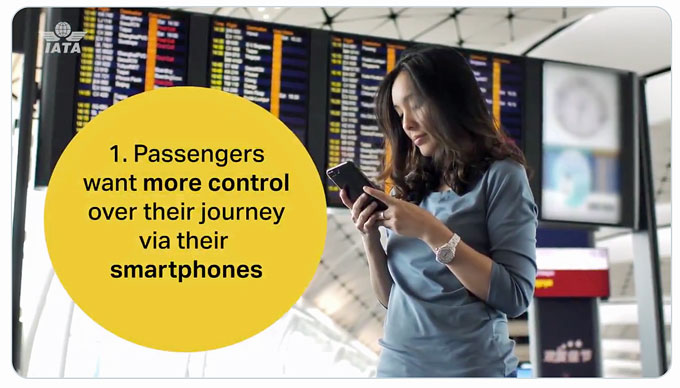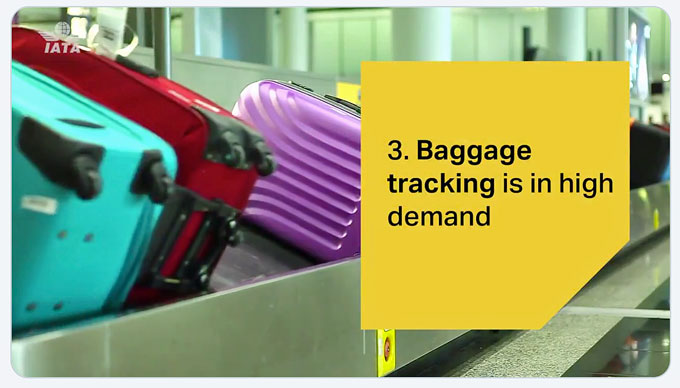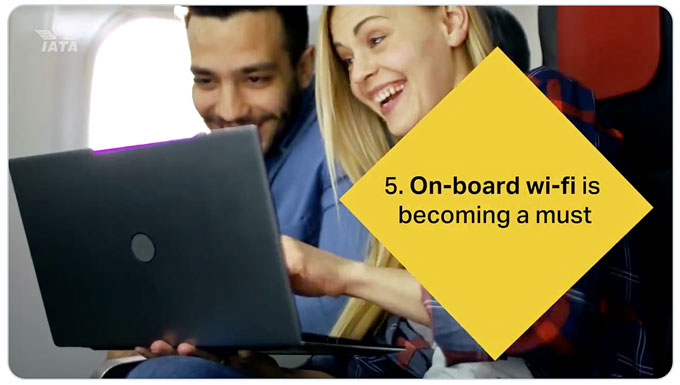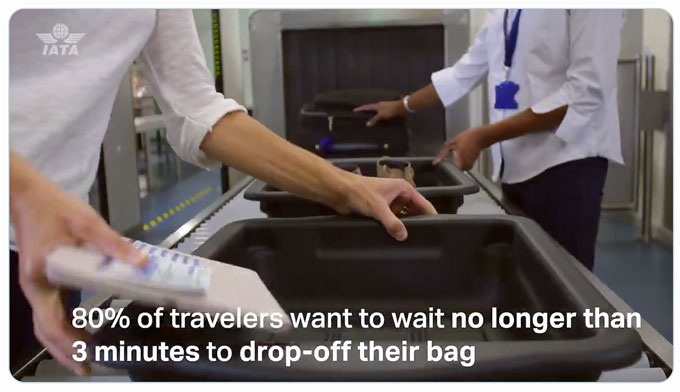
The International Air Transport Association (IATA) has released its 2019 Global Passenger Survey results, which highlights that passengers are looking to technology to improve their travel experience.
Acting as the voice of the passenger, the survey provides objective and in-depth insights into the preferences and behaviors of air travelers around the world, helping to guide industry initiatives.
The primary focus of the survey was on processes and technology in the travel experience, not airline or airport service levels.
Top passenger priorities identified includes:
- Having more personal control over their journey via their smart phone
- Being able to use biometric identification to speed up travel processes
- To be able to track their baggage
- Maximum wait times of 10 minutes for baggage collection and immigration/customs
- Access to Wi-Fi on board at 34,000ft
(See 5 Key findings from the 2019 Global Passenger Survey results. Courtesy of IATA and YouTube. Posted on Oct 11, 2019.)
More Control
Passengers want to use their personal device to control more aspects of their travel journey from booking to arrival.
An airline app was the preferred method of booking for passengers from one of the world’s largest aviation markets, with 24% of travelers from North Asia preferring this method.
It was also the second most popular choice among passengers in the Middle East, favored by 14% of travelers.

Booking through an airline website, although less popular than in 2018, remains the method of choice for most travelers globally (39%).
Using a smartphone was also identified by more than half of passengers (51%) as their preferred method of check-in, which is a 4% increase over 2018.
Most passengers (72%) also wanted to be kept informed throughout their journey via travel notifications sent to their personal device.
SMS remains the preferred notification option for 39% of passengers, but this trend has been decreasing since 2016.
Conversely, preference for receiving information via a smartphone app has increased by 10% since 2016 and is now the method of choice for one third of passengers.
The survey found that 83% of passengers want to receive information on the status of their flight and 45% would like information on their baggage.
Passengers also asking for information to help them plan their passage through the airport with 45% wanting to know wait times at security and border control and 37% wanting to know wait times at customs.
Biometric technology to speed up airport processes
The survey found that 70% of passengers are willing to share additional personal information including their biometric identifiers to speed up processes at the airport.

This increases in correlation with the number of flights taken per year. The highest support for this (76%) is among fliers who travel for business, more than 10 times per year.
In addition, 46% of passengers would prefer to use biometric identification instead of a paper passport for their journey and 30% would opt to use a biometric token to board the plane.

These findings lend strong support to IATA’s One ID project which aims to create a paperless airport experience for passengers where they can move from curb to gate using a single biometric travel token such as a face, fingerprint or iris scan.
“Passengers are willing to share more personal information if it removes hassle from their travel experience,” explains Alexandre de Juniac, IATA’s Director General and CEO.
“But it’s clear that concerns over data privacy remain.
“While the majority of passengers want to use biometric identification instead of a paper passport, 53% of those that did not, said they were concerned about the security of their data.”
“Passengers need to be confident that their data is safe.”
(One ID introduces an opportunity for the passenger to further streamline their journey with a document-free process based on identity management and biometric recognition. Passengers will be able to identify themselves at each airport touchpoint through a simple biometric recognition. The objective is to achieve a truly interoperable system coordination between airports, airlines and governments. Courtesy of IATA and YouTube. Posted on Sep 26, 2019.)
Securing data is paramount for One ID and IATA is working on a trust framework that ensures that:
- Stakeholders have access to passenger data on an authorized, need-to-know basis only
- There are exception processes in place for those who do not want to share their biometric data and
- Privacy and data regulations are adhered to.
High demand for baggage tracking
Over half of passengers (53%) said that they would be more likely to check their bag if they were able to track it throughout the journey.

And 46% said that they want to be able to track their bag and have it delivered directly to an off-airport location, if that service were available.
Airlines and airports are working together to improve baggage information reliability by tracking baggage at major touch points such as loading and unloading (the implementation of IATA Resolution 753).
And the 75th IATA AGM unanimously resolved to support the global deployment of Radio Frequency Identification (RFID) for baggage tracking.
RFID read rates are 99.98% accurate which is significantly better than that of bar codes.
Time is of the essence for passengers
The survey indicated that 80% of passengers want to wait no longer than three minutes to drop off a bag.

This increased to 10 minutes for queuing at immigration/customs for 79% of travelers.
And only 2% would accept a waiting time longer than 20 minutes. Passengers (74%) also want to wait no longer than 10 minutes for baggage delivery.
And almost none wants to wait longer than 20 minutes.
The survey also found that for nearly three quarters (74%) of passengers, speed was the main benefit of using automated immigration gates/kiosks.
A similar number (72%) gave the overall experience of automated immigration processing a thumbs up.
Onboard Wi-Fi
Passengers want onboard Wi-Fi.

Some 53% of surveyed passengers found Wi-Fi important to have.
The importance is the highest in Africa (71%), Latin America (68%) and the Middle East (67%) and the lowest in Europe (44%) and North America (49%).
With availability of Wi-Fi connectivity continuing to have a direct impact on the overall travel experience, adopting the latest onboard Wi-Fi technology continues to be an effective way for airlines to distinguish their product offering.
Passenger pain points
Passengers once again identified airport security screening process and border control as two of their biggest pain points when traveling.

Having to remove personal items was identified as a pain point by the most travelers (60%), closely followed by the removal of laptops and large electronic devices (48%) and variations in screening processes at different airports (41%).
To improve the boarding experience, the top three passenger suggestions are:
- More efficient queuing at the boarding gate (60%),
- Not needing to get a bus to the aircraft (51%) and
- More bin space for cabin luggage (46%).
To improve the connection experience, the top three desires from travelers are not having to go through security at the transfer airport (60%), not having to pick up and reclaim their bag at the transfer airport (59%) and not having to pass immigration at the transfer airport (55%).
NEXTT
Many of the identified demands of passengers are covered by the NEXTT (New Experience in Travel and Technologies) initiative.
This is a joint IATA and ACI (Airports Council International) effort to develop a common vision to enhance the on-ground transport experience, guide industry investments and help governments improve the regulatory framework.
(Increasing the use of digital identity management, automation and robotics to further improve customer experience, bring greater operational efficiency and increase safety and security. Courtesy of IATA and YouTube. Posted on Dec 11, 2018.)
The goal of NEXTT is finding ways to integrate systems and improve operations in the most secure, effective and sustainable manner for the benefit of passengers and the industry.
“Passengers have told us that they are looking to technology to improve their travel experience,” explains Nick Careen, IATA Senior Vice President Airport Passenger Cargo & Security.

“That is what we are trying to deliver in cooperation with airports.”
“Through our NEXTT initiative with ACI we aim to deliver a seamless curb-to-gate experience for passengers.”
“But industry can’t achieve this alone.
“Government support is essential to create the correct regulatory environment so the industry can fully transform.”
The 2019 survey results were based on 10,877 responses from passengers across 166 countries.

The International Air Transport Association (IATA) is the trade association for the world’s airlines, representing some 290 airlines or 82% of total air traffic.
AST strives to meet a 3 STAR trustworthiness rating, based on the following criteria:
- Provides named sources
- Reported by more than one notable outlet
- Includes supporting video, direct statements, or photos

















